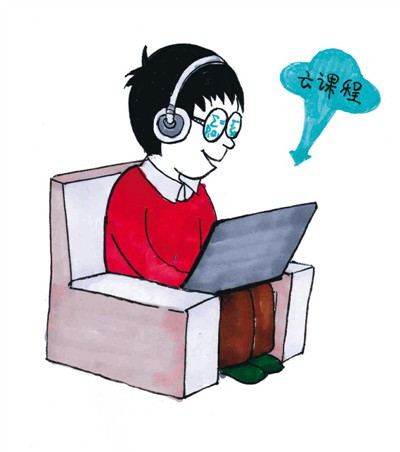 “A university on the cloud is a university that is mainly supported by cloud technology”, said Yang Zhijian, President of the Open University of China (OUC), during “Cloud China 2014”.
“A university on the cloud is a university that is mainly supported by cloud technology”, said Yang Zhijian, President of the Open University of China (OUC), during “Cloud China 2014”.
Shifting education to the cloud led to the creation of new teaching methods. Through the Internet, users have access to massive amounts of information no matter their physical location; they would be able to access the cloud any time and in any place in order to further their objectives. Thus was cloud-based education born, an education mechanism defined, not by fences, but by wings.




Modern Cloud Technology Accelerates the Birth of New Learning Revolution
With the development and application of cloud technology, great change is taking place in the field of education. Education methods have transformed from being limited to the grounds of a university to being spread out and integrated into society, from being focused on educating the young to being able to reach people of any age, thus promoting the lifelong learning for all, from only focusing on professional education to focusing on a variety of education. Obviously, open education has become a global trend, and thus the construction of the OUC is an historic development in the world of education.
Compared with traditional universities, what are the characteristics of the new OUC? President Yang Zhijian explained, “The OUC, overseen directly by the Ministry of Education (MOE), emphasizes open thought, open method, open approach, and open target, and takes full advantage of the latest developments in information technology to implement distance education, opening up the prospect of higher education to any who are willing and able to learn.”
The emergence and development of the open university is of great historic and practical significance in meeting the economic needs of society and its members, specifically in relation to the diversification of education, cultivating a strong and unified population, and promoting educational fairness and social equity. Since the UK's first Open University was founded in the early 1970s, it has gradually garnered more and more attention and recognition, has won the affirmation and support of governments in countries around the world, and has become a crucial trend in the reform and development of education, and now China is joining the global open university trend.
Classroom in the Air Upgraded into Conversation above the Cloud
The reason why the OUC is seen as a new university model is that it is defined by its integration with modern information technology. The OUC is built on the foundation of China Central Radio & TV University (CCRTVU), however, its evolution is more than just a name change, it encompasses a complete change in education methods and practical application based on the national strategy of invigorating China's scientific, education, and human resources development, all in the interest of achieving national development goals.
“Five-minute Class”, “Online Core Courses”, “Cloud Classroom”, and “Credit Bank”, new terms like these in the education field are a reflection of the reform and innovation of the OUC in education and teaching, the goal of which is to satisfy people’s needs of lifelong learning and individualized learning.
The project “Five-minute Class”, launched by the OUC at the end of 2012, focused on the creation of five-minute courses, with content aimed at meeting the needs of ordinary people in education related to clothing, food, shelter, and transportation.
"Online Core Courses" are major professional courses designed to deliver degree-based curriculum via the Internet. It adopts an approach combining the uploading of educational resources and tutors’ participation to provide multifaceted services such as daily tutoring, Q&A, and urgent assistance. Students' questions and problems can promptly be solved through various Internet communication modes including forums, email, and QQ, in many technical and practical ways becoming similar to the recently popular MOOCs. The setup of “Online Core Courses” is a crucial step of the construction of the “six-network integration mode” of the OUC, and plays an important role in guaranteeing the teaching quality and realizing the goal of learner formation.
In April 2012, “The OUC's Cloud Classroom Construction Pilot Project” was officially inaugurated due to the fact that there were no extant models which could be used for reference. It would explore using the Internet to move the classroom to the cloud, and the integration of information between the teachers and students. The Cloud Classroom makes the most benefit of the faculty in the OUC system by improving the experience of learners and utilizing the dimensionality of the Internet to better facilitate faculty construction. All teaching resources are stored in the “cloud”, allowing teachers and students the freedom to interact at any time or place as long as they have access to a "cloud" terminal. To some extent, it mitigates the problems of low attendance and poor teaching quality during face-to-face tutorial.
“Credit Bank”, also set up by the OUC, is a bank in the sense that it operates according to the same fundamental principles of any bank, but is also a system wherein students are free to choose their learning content, time, and location. The “Credit Bank” system has led to a breakthrough in mutual accreditation and the transferring of credits between educational institutions and training organizations, encouraging students to accumulate credits through all kinds of learning. It has thus stimulated communication and connection between degree education and non-degree education, promoting the formation of an open learning system.
Individual Customization Creating Knowledge Supermarket for All
The position of the OUC is that by utilizing modern information technology, targeting people from all social levels, and paying equal attention to degree and non-degree education, the possibility exists to construct a modern open and distance university without geographical limits, one defined by a three-dimensional network with nationwide coverage, including both metropolitan and rural communities. The historic mission of the OUC is to accelerate the formation of a system of flexible and open lifelong education and the formation of a learning society with lifelong learning for all. The primary mission of the OUC can be summarized as the vigorous development of non-degree continuing education and the continued development of degree continuing education to meet the various learning needs of society; exploring the deep integration of modern science and technology with education to advance and take the lead in educational digitization and educational modernization; integrating educational resources of high quality and making them accessible to the vast rural areas, old revolutionary base areas, borderlands, and minorities in order to meet the educational needs of specific groups, vulnerable groups, and the disabled, thus meeting their educational needs and promoting educational equality. The strategic target of the OUC is to become an important pillar in a learning society, a new model of university in the system of higher education, as well as a top-class open university among open universities worldwide.
The OUC can be analyzed from many perspectives. From the social perspective, the OUC is a learning supermarket for the whole country, in which members of society can freely choose educational products according to their own interest, hobbies, and needs. The more numerous the categories, the better the system can meet the various needs of society. From a political perspective, the OUC is a supplier of learning products. From a university prospective, the OUC is a producer of learning products.
The foundation of the OUC has not only conformed to the worldwide trend in educational development, but also created a new model for educational development in China. Besides bringing high quality class and system management to the campus, it also spreads knowledge and ideas to society as a whole, and even to the world. It is open not only to the students but also to all people, indeed reflecting the concept of putting people first, with the ultimate goal of scientific development.
“The dream is far, and the road is long, yet we expect it to come true”, said President Yang Zhijian.
Link 1: The Open University of China (OUC)
The OUC, built on the foundation of the former CCRTVU and the local RTVUs, was officially established at a nameplate unveiling ceremony held on July 31, 2012. The current president is Yang Zhijian. The school system of the OUC consists of the headquarters, branches, local colleges, learning centres, industrial colleges, and corporate colleges. The OUC adopted a two-level administration system comprised of a headquarters level and a branch level, operating on the principle of “unified strategy, common platforms, resource sharing, relative independence, and distinction”. Based on modern information technology, the OUC provides education to the entire country. It emphasizes both degree education and non-degree education and is open to all members of society. Therefore, it is called a “new university without barriers”. There are more than 3 million enrolled students, including nearly 200,000 farmer students, nearly 100,000 sergeant students, and more than 6,000 disabled students.
Link 2: Cloud Computing Education
Cloud computing education refers to the application of cloud-based technology in education. Cloud computing education gathers teaching, management, learning, entertainment, sharing, and interaction together and makes it available for schools, teachers, students, parents, and other education-related applications to collaborate via one platform, with access assigned according to needs.
Cloud-based education is not just a website, but also a service platform for education digitization. Cloud-based education consists of cloud-based training and management systems, distance education training systems, and websites of training organisations. It aims to share educational resources and achievements, making all aspects of education accessible via a "one-stop" education network and the idea of "cloud".
Link 3: “MOOCs”
MOOCs refer to the free online courses provided jointly by the world’s top universities. It is known as “the biggest innovation of education since printing” and “the dawn of the future education”. MOOCs break down the “walls” among universities and promote the new “learning revolution”.
As an online course development model that has emerged in recent years, MOOCs are posted online by individuals and organizations in the spirit of sharing and cooperation and in order to enlarge the scope of dissemination and improve the impact of knowledge. “M” in “MOOC” stands for “Massive”. Compared to traditional courses, MOOCs have a large number of participants. One course may have thousands of participants. “O” stands for “Open”. MOOCs don’t have geographic limitations. The only thing that a participant needs is a mailbox. The second “O” stands for “Online”. MOOCs are delivered online without time constraints. The fourth letter “C” stands for “Course”.
MOOCs started in 2011 and swept around the world within one year. Influential provider platforms like Coursera, Udacity, and others were gradually formed. Famous universities in China, including Tsinghua University, Peking University, Fudan University, and Shanghai Jiaotong University, set up MOOCs one after another and created a MOOC storm. (People’s Daily Overseas Edition, Eighth Edition, March 29, 2014)
By People’s Daily